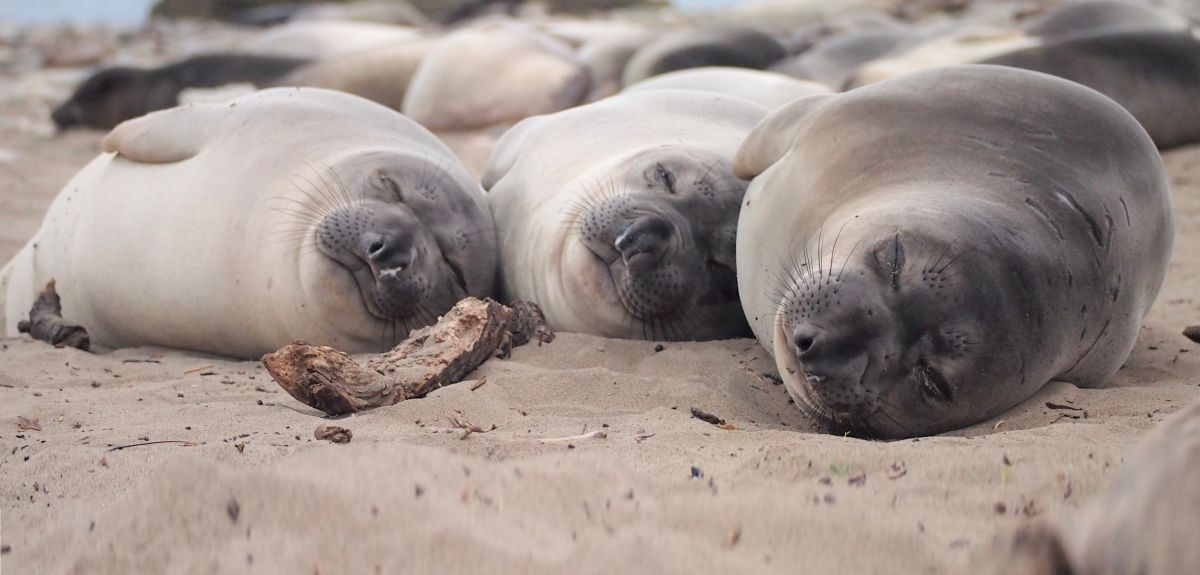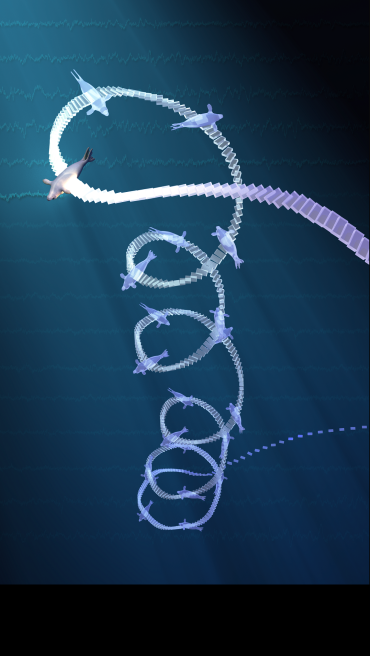
Elephant seals drift off to sleep while diving far below the ocean surface
A new analysis of elephant seal brainwave patterns has revealed that these mammals take short naps while holding their breath on deep dives, averaging just 2 hours of sleep per day during their long trips at sea. The findings have been published today in the journal Science.
For many years, researchers have been mystified about how the northern elephant seal, (Mirounga angustirostris), one of the world’s elite divers, gets enough sleep when it forages at sea. During these trips, which can last up to 8 months, the seals are constantly diving, both to avoid predators such as killer whales and because their colossal energy needs compel them to keep searching for food. But unlike cetaceans and ‘eared’ seal species (such as sea lions), elephant seals cannot perform unihemispheric sleep, where one half of the brain rests and the other half remains alert.
This left an intriguing, unanswered question – when and how do elephant seals sleep?
 Data-driven graphic showing sleeping postures every 20 seconds and accompanying 30-second segments of EEG traces in the background. Graphic by Jessica Kendall-Bar. NMFS 23188.
Data-driven graphic showing sleeping postures every 20 seconds and accompanying 30-second segments of EEG traces in the background. Graphic by Jessica Kendall-Bar. NMFS 23188.
The research team, led by Dr Jessica Kendall-Bar (UC San Diego’s Scripps Institution of Oceanography) as part of her dissertation at UC Santa Cruz with Drs Terrie Williams and Daniel Costa, developed a bespoke tool to record brain activity (electroencephalogram, EEG) data in wild elephant seals during their normal diving behaviour at sea. The EEG sensors were secured to the seals using a neoprene headcap, which the researchers recovered when the animals returned to the beach. The seals carried a small data logger to store the EEG data alongside time-depth records and motion sensing data that allowed the researchers to track the seals’ movements along with the corresponding brain activity.
Ritika Mukherji, a Masters student and Rhodes Scholar in the University of Oxford’s Department of Neuroscience, contributed to the data analysis in the study. ‘It is an incredible achievement to have recorded such high-quality data in a wild mammal freely moving in such an extreme environment. Not only were we able to identify periods when the seals were asleep, but we could also distinguish the main different phases of sleep, that is slow-wave sleep (SWS) and rapid-eye-movement (REM) sleep.’
The system collected data from 13 juvenile female seals diving in Monterey Bay, California. Using this data, the researchers then developed a high-accuracy sleep identification algorithm that could detect periods of inactivity from recorded diving data. This enabled them to estimate sleep quotas for 334 adult seals using dive data recorded over several months during their foraging trips.
The results are remarkable for documenting the first known case of REM sleep in a wild, unrestrained marine mammal. Unlike other marine mammals that perform unihemispheric sleep and maintain some motor control, elephant seals really seem to “let themselves go” completely during these dives.
Ritika Mukherji, Department of Neuroscience, University of Oxford
The results showed that the seals sleep for about 10 minutes at a time during deep, 30-minute dives. During SWS, the first deep sleep stage, the seals still had postural control and maintained a controlled glide downwards. After a few minutes, they transitioned to REM sleep and entered sleep paralysis, which caused them to turn upside down and drift down in a “sleep spiral.” In shallower waters over the continental shelf, elephant seals sometimes slept motionless while resting on the seafloor.
The study also revealed that elephant seals apparently repay their massive sleep debts by switching to a different regime once they return to dry land. Once they were out of the water and safe from predators, their daily sleep time was over 5 times higher than when at sea and over 10 hours per day. Certain migratory birds are known to similarly fluctuate between extreme variations in daily sleep duration, but this is the first time such behaviour has been recorded in mammals.
Remarkably, Ritika’s involvement in the study was due to serendipitous chance, when she came across Jessica Kendall-Bar’s website whilst she was an undergraduate studying Zoology at Miranda House, University of Delhi in India. ‘I sent Jessica a message to say how interested I was in her work and she responded two minutes later to ask if I would like to help her with a new study. I ended up working on the study for one and a half years, which ultimately shaped my ambition to study neuroscience as a postgraduate.’
 Ritika Mukherji.
Ritika Mukherji.‘It has been a dream come true to work on this study, even though the work was challenging at times, particularly because most sleep studies have focused on humans with few looking at animals. But it has really influenced my current long-term career ambition, which is to become a researcher in veterinary science, helping to develop new non-invasive methods to study wild animals. Jessica has been the best mentor I could ask for.’
Dr Jessica Kendall-Bar said: ‘Ritika led an extensive and rigorous review of the literature on the methods employed across laboratory and wild sleep studies to help establish that our study was novel in that it is the first to record sleep in wild, free-ranging marine mammals. While reading over a hundred papers on sleep might deter some, Ritika has continued on to study sleep at Oxford with one of the top sleep research groups. It has been a pleasure to work with and learn from her as well as the other interns in my group.’
The study ‘Brain activity of diving seals reveals short sleep cycles at depth’ has been published in Science.
 New study finds that ChatGPT amplifies global inequalities
New study finds that ChatGPT amplifies global inequalities
 Expert Comment: Chatbot-driven sexual abuse? The Grok case is just the tip of the iceberg
Expert Comment: Chatbot-driven sexual abuse? The Grok case is just the tip of the iceberg